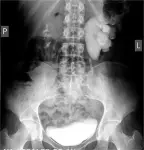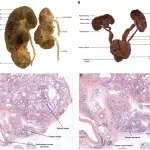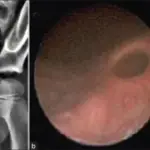Ureteropelvic junction obstruction is defined as an obstruction of the flow of urine from the renal pelvis to the proximal ureter.
What is the Pathology of Ureteropelvic Junction Obstruction?
The pathology of Ureteropelvic junction obstruction is:
-Etiology: The etiology of ureteropelvic junction obstruction includes stenosis due to scarring of ureteral valves.
-Genes involved: AGTR2, BMP4, Id2.
-Pathogenesis: The sequence of events that lead to ureteropelvic junction obstruction includes partial or intermittent blockage of the flow of urine that occurs where the ureter enters the kidney.
-Morphology: The morphology associated with ureteropelvic junction obstruction shows marked dilatation of the renal calyces and pelvis, funneling down to a narrow beak end, with non visualization of the ipsilateral ureter.
-Histology: The histology associated with ureteropelvic junction obstruction shows parenchymal damage.
How does Ureteropelvic Junction Obstruction Present?
Patients with ureteropelvic junction obstruction typically affect males twice more than females usually presenting in the pediatric age group. The symptoms, features, and clinical findings associated with ureteropelvic junction obstruction include hydronephrosis. Older children may present with urinary tract infection (UTI), hematuria, a flank mass, or intermittent flank pain secondary to a primary UPJ obstruction. Adults with UPJ obstruction can present with various symptoms, including back and flank pain, UTI, and/or pyelonephritis.
How is Ureteropelvic Junction Obstruction Diagnosed?
Ureteropelvic junction obstruction is diagnosed using complete blood count, kidney function tests, including creatinine, GFR, and BUN.
How is Ureteropelvic Junction Obstruction Treated?
Ureteropelvic junction obstruction is treated by surgical intervention.
What is the Prognosis of Ureteropelvic Junction Obstruction?
The prognosis for ureteropelvic junction obstruction is good as it resolves gradually.



